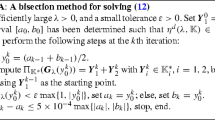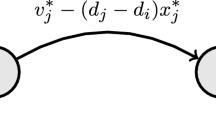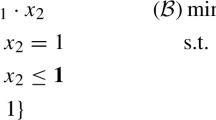Abstract
We investigate in this paper the duality gap between quadratic knapsack problem and its Lagrangian dual or semidefinite programming relaxation. We characterize the duality gap by a distance measure from set {0, 1}n to certain polyhedral set and demonstrate that the duality gap can be reduced by an amount proportional to the square of the distance. We further discuss how to compute the distance measure via cell enumeration method and to derive the corresponding improved upper bound of the problem.
Similar content being viewed by others
References
Allemand K., Fukuda K., Liebling T.M., Steiner E.: A polynomial case of unconstrained zero-one quadratic optimization. Math. Program. 91, 49–52 (2001)
Avis D., Fukuda K.: Reverse search for enumeration. Discret. Appl. Math. 65, 21–46 (1996)
Billionnet A., Faye A., Soutif E.: A new upper bound for the 0–1 quadratic knapsack problem. Eur. J. Oper. Res. 112, 664–672 (1999)
Billionnet A., Soutif E.: An exact method based on Lagrangian decomposition for the 0–1 quadratic knapsack problem. Eur. J. Oper. Res. 157, 565–575 (2004)
Caprara A., Pisinger D., Toth P.: Exact solution of the quadratic knapsack problem. INFORMS J. Comput. 11, 125–139 (1999)
Chaillou P., Hansen P., Mahieu Y.: Best network flow bounds for the quadratic knapsack problem. Lect. Notes Math. 1403, 226–235 (1986)
Fang S.C., Gao D.Y., Sheu R.L., Wu S.Y.: Canonical dual approach to solve 0–1 quadratic programming problems. J. Ind. Manag. Optim. 4, 125–142 (2008)
Ferrez J.A., Fukuda K., Liebling T.M.: Solving the fixed rank convex quadratic maximization in binary variables by a parallel zonotope construction algorithm. Eur. J. Oper. Res. 166, 35–50 (2005)
Gallo G., Hammer P.L., Simeone B.: Quadratic knapsack problems. Math. Program. Study 12, 132–149 (1980)
Gallo G., Simeone B.: On the supermodular knapsack problems. Math. Program. 45, 295–309 (1988)
Gao D.Y., Ruan N., Sherali H.D.: Solutions and optimality criteria for nonconvex constrained global optimization problems with connections between canonical and Lagrangian duality. J. Glob. Optim. 45, 473–497 (2009)
Hammer P.L. Jr, Rader D.J.: Efficient methods for solving quadratic 0–1 knapsack problems. INFOR 35, 170–182 (1997)
Helmberg, C.: Semidefinite programming for combinatorial optimization. Technical report, Konrad-Zuse-Zentrum, Berlin. ZIB-Report ZR-00-34. ftp://ftp.zib.de/pub/zib-publications/reports/ZR-00-34.pdf. (2000)
Helmberg C., Rendl F., Weismantel R.: Quadratic knapsack relaxations using cutting planes and semidefinite programming. Integer Programming and Combinatorial Optimization. Lect. Notes Comput. Sci. 1084, 175–189 (1996)
Helmberg C., Rendl F., Weismantel R.: A semidefinite programming approach to the quadratic knapsack problem. J. Comb. Optim. 4, 197–215 (2000)
Laurent M., Rendl F.: Semidefinite programming and integer programming. In: Aardal, K., Nemhauser, G., Weismantel, R. (eds) Discrete Optimization, pp. 393–514. Elsevier, Amsterdam (2005)
Li D., Sun X.L.: Nonlinear Integer Programming. Springer, New York (2006)
Michelon P., Veilleux L.: Lagrangian methods for the 0–1 quadratic knapsack problem. Eur. J. Oper. Res. 92, 326–341 (1996)
Nesterov Y., Nemirovskii A.: Interior-Point Polynomial Algorithms in Convex Programming. SIAM, Philadelphia, PA (1994)
Pisinger D.: The quadratic knapsack problem–a survey. Discret. Appl. Math. 155, 623–648 (2007)
Sleumer N.: Output-sensitive cell enumeration in hyperplane arrangements. Nord. J. Comput. 6, 137–161 (1999)
Wang Z.B., Fang S.C., Gao D.Y., Xing W.X.: Global extremal conditions for multi-integer quadratic programming. J. Ind. Manag. Optim. 4, 213–225 (2008)
Zaslavsky T.: Facing up to arrangements: face-count formulas for partitions of space by hyperplanes. Mem. Am. Math. Soc. 1, 1–101 (1975)
Zheng, X.J.: Studies on the Theory and Methods for Continuous and Integer Nonconvex Quadratic Programming Problems. PhD thesis, Shanghai University, Shanghai, China (2009)
Author information
Authors and Affiliations
Corresponding author
Rights and permissions
About this article
Cite this article
Zheng, X.J., Sun, X.L., Li, D. et al. On reduction of duality gap in quadratic knapsack problems. J Glob Optim 54, 325–339 (2012). https://doi.org/10.1007/s10898-012-9872-9
Received:
Accepted:
Published:
Issue Date:
DOI: https://doi.org/10.1007/s10898-012-9872-9




